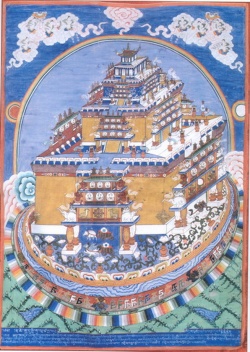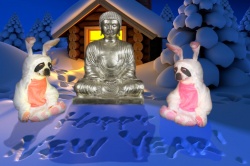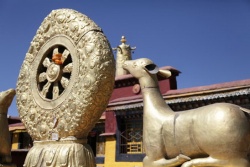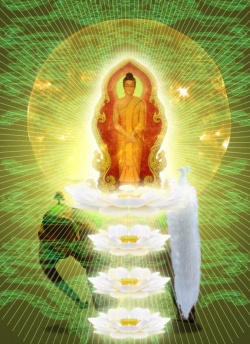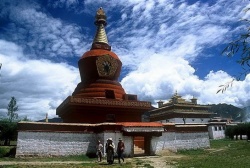Alms-giving
The UNESCO World Heritage City of Luang Prabang is the perfect place to see one of the most sacred Lao traditions, the Buddhist Alms Giving Ceremony. Despite being a highly revered ritual for locals, visitors are encouraged to be involved as long as a level of respect is maintained throughout.
Alms giving takes place daily as the sun rises, beginning on the main street of Luang Prabang before spreading out to all the side streets. You should buy your offerings (usually food) in advance and arrive with plenty of time to spare as it’s considered very offensive to disrupt the ceremony once it has commenced.
Follow the guidance of the locals by kneeling down ready to give your offering to the monks; most common gifts include rice, fresh fruit and traditional sweet snacks. The idea of the alms giving is for the Buddhist monks to make merit and also to collect food for their one meal of a day.
Alms Giving Ceremony Highlights
As the sun rises in Luang Prabang around 200 Buddhist monks depart from their various temples to gather their daily meal. The tradition of alms gathering dates back to the 14th century, yet still today locals wake early to prepare the food for the monks and wait quietly by the roadside to give their gifts. Although the main purpose is for locals to give alms to the monks, you will also notice small children kneeling with baskets in the hope that the monks will share some of their alms with them so that they can take food back to their family.
This daily ceremony is both peaceful and spiritual and gives you a wonderful opportunity to experience an ancient Lao tradition. The procession is quite lengthy and therefore not suitable for very young children or those who cannot sit quietly for more than a few minutes. If you are taking photographs it is best to step back from the front of the line to avoid causing offence. If you are not making an offering maintain an appropriate distance and do not under any circumstances get in the way of those making an offering. Visitors should also remember to be there before the monks arrive and never ever to follow the procession.
There are many unspoken rules regarding etiquette when attending an Alms Giving Ceremony, firstly shoulders, chests and legs must be covered in modest clothing as a mark of respect. You should also remain at a suitable distance from the monks and do not interrupt the procession under any circumstances. Therefore photographs may be taken, but from a distance and never use a camera flash.
When seated, shoes and socks must be removed with your feet tucked underneath as you observe the ceremony in absolute silence. Female attendees must keep their head lower than the monks when giving alms and they must not talk to or touch the monks at any time, even when making an offering. Suitable offerings include some simple food which you can probably arrange at your hotel or buy from a local market en-route, if you buy alms on the street do not negotiate on price as this is also considered highly disrespectful.
Offering food is one of the oldest and most common rituals of Buddhism. Food is given to monks during alms rounds and also ritually offered to tantric deities and hungry ghosts. Offering food is a meritorious act that also reminds us not to be greedy or selfish.
Offering Alms to Monks
The first Buddhist monks did not build monasteries. Instead, they were homeless mendicants who begged for all their food. Their only possessions were their robe and begging bowl.
Today, in many predominately Theravada countries like Thailand, monks still rely on receiving alms for most of their food. The monks leave the monasteries early in the morning. They walk single file, oldest first, carrying their alms bowls in front of them. Laypeople wait for them, sometimes kneeling, and place food, flowers or incense sticks in the bowls. Women must be careful not to touch the monks.
The monks do not speak, even to say thank you. The giving of alms is not thought of as charity. The giving and receiving of alms creates a spiritual connection between the monastic and lay communities. Laypeople have a responsibility to support the monks physically, and the monks have a responsibility to support the community spiritually.
The practice of begging for alms has mostly disappeared in Mahayana countries, although in Japan monks periodically do takuhatsu, "request" (taku) "with eating bowls" (hatsu). Sometimes monks recite sutras in exchange for donations. Zen monks may go out in small groups, chanting "Ho" (dharma) as they walk, signifying that they are bringing the dharma.
Monks practicing takuhatsu wear large straw hats that partly obscure their faces. The hats also prevent them from seeing the faces of those giving them alms. There is no giver and no receiver; just giving and receiving. This purifies the act of giving and receiving.
Other Food Offerings
Ceremonial food offerings also are a common practice in Buddhism. The precise rituals and doctrines behind them differ from one school to another. Food may be simply and silently left on an altar, with a small bow, or the offering might be accompanied by elaborate chants and full prostrations. However it is done, as with the alms given to monks, offering food on an altar is an act of connecting with the spiritual world. It is also a means to release selfishness and open the heart to the needs of others.
It is a common practice in Zen to make food offerings to the hungry ghosts. During formal meals during sesshin, and offering bowl will be passed or brought to each person about to partake of the meal. Everyone takes a small piece of food from his bowl, touches it to the forehead, and places it in the offering bowl. The bowl is then ceremonially placed on the altar.
Hungry ghosts represent all of our greed and thirst and clinging, which bind us to our sorrows and disappointments. By giving away something that we crave, we unbind ourselves from our own clinging and neediness to think of others.
Eventually the offered food is left out for birds and wild animals.
